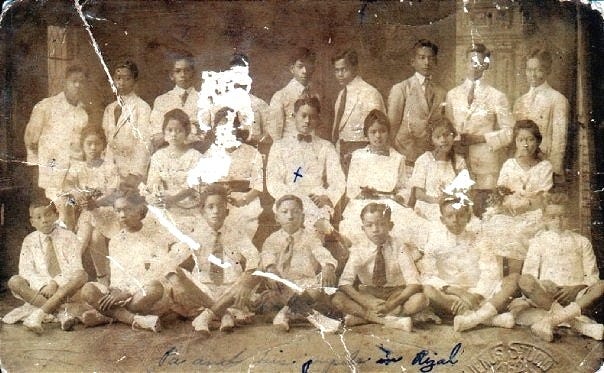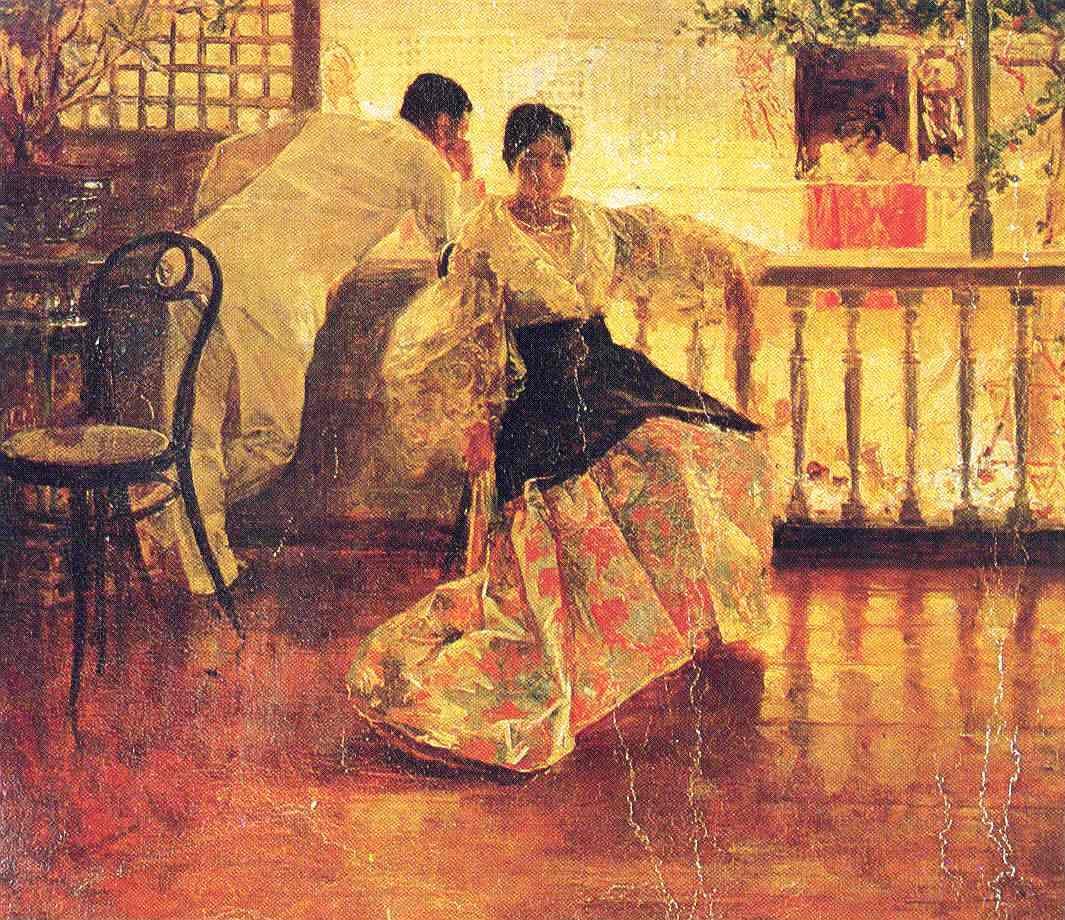V is for Vergara (My so-called Spanish Bloodline)
#22 of 26 in the ABCs of Recovering Ilocano series

Growing up, I believed I was one-third Filipino, one-third Chinese, and one-third Spanish. Mama explained the Chinese genes from the merchants. “They traded with the Philippines even before the Spanish came.”
Our family tree is peppered with Spanish names as I described in E is for Eleccion, in which I discussed the Spanish alphabetization decree. The assigned family name letter for San Esteban was E, but a family was allowed to keep their name if they could prove it had been in their family for more than four generations.
“Where did the name Vergara come from?” I asked Mama.
“My ancestors came from the Basque region of Spain,” Mama said with pride, as many Filipinos do when they attribute descent to the Spaniards. She is our family's genealogy expert and has documented her father’s ancestry fourteen generations back.
We were at one family party, and as in many families, one sibling seemed to be the outlier, not necessarily a black sheep, but different from the rest. In our family, the middle sister is imaginative, creative, entertaining, and is always the center of attention.
“Are you even related to us?” we often tease her. Still, we enjoy how she tells stories. Her eyes light up like glittery ornaments. Her hands wave in the air to punctuate her sentences. We are a captive audience, hypnotized under her magic.
“Yes, I wondered that too,” Mama said, to our delighted gasps and laughter.
She continued, “When she was born, she was so beautiful, like a little porcelain doll! Her nose was sharp, you could tell that even at one day old she was a mestiza. I asked the nurse, ‘Are you sure she is mine?’ and she plopped her into my hands. So I took her home.”
In the Philippines, mestizo or mestiza means mixed parentage and is often a compliment. My sister is one, and we nicknamed her “Tisay.” She undoubtedly inherited the Spanish features from both sides of the family, as Papa also had some from the Rosario family in Lapog, Ilocos Sur.
To settle the matter of her parentage, I gave everyone DNA ancestry kits for Christmas. I am still waiting for said sister to prove she belongs to us.
I received my results, and the joke’s on me. My imagined pie chart divided into even thirds was only a figment of my imagination. I was 0% Spanish, 1% Central and Eastern Chinese, and 99% Northern Philippines.
Ancestry.com updates yearly, and in 2024, I get reclassified as belonging to Luzon. In addition, I get 1% Spanish. As a lab scientist, I can’t help but measure it in terms of the blood volume. If the average woman has 4.5 liters of blood, one percent is 45 ml, about three tablespoons. My Spanish and Chinese heritage amounts to one and a half dosage cups of Nyquil.
Mama had always attributed her father’s patrician nose and fair skin to ancestors from the Basque region of Spain. “He has a high forehead, a sign of intelligence,” she says.
Here are my DNA percentages compared to my mother’s.
I looked up Basque, and to my surprise, the chemical element Tungsten was discovered there in 1783. It is a metal for making alloys, carbides, and other compounds. Little is written about this town, but it tickled me that it has a famous Laboratorium Bergara.
A quick search shows that Vergara is a common name in many countries Spain had colonized. In the Philippines, the Vergara name in the northern Ilocos is thought to have originated from Pampanga, a province in Central Luzon. Across the world, it is found in Mexico, Chile, Colombia (like the actress Sofia Vergara), and Spain, not counting the people in the diaspora. The Vergara name is also associated with nobility, as the coats of arms in the following images show.

A Complicated Heritage
Many in the family would like to be traced back to royalty. It is an instinct, much like Americans' tracing their lineage to someone who sailed on the Mayflower or how English people claim a bloodline to the kings and queens of the British Empire.
When I reviewed our family tree, I found that we originated from a certain Padre Agaton Vergara. I was shocked and asked Mama, “Padre? Like a friar?”
She nodded. “Maybe.”
My skin crawled. In high school Filipino literature, we read Jose Rizal's novels, Noli me Tangere and El Filibusterismo. The Catholic Church later banned the books because they cast the prayle or the friars in a bad light. There’s Padre Damaso in the opening scene, grumbling at being served the neck and wing, the least desirable parts of the tinola, chicken stewed in ginger. Pride and envy were the least of his undesirable attributes. It was later revealed that while he posed as the beautiful heroine Maria Clara’s godfather, he was truly her father. He had violated Capitan Tiago’s wife, Doña Pía Alba, who died giving birth to Maria Clara.
What do I do with information like this?
I wrote Decolonizing my Flat Filipino Nose for an AAPI Workshop last year. Now I have to figure out how to decolonize the rest of my body and mind. The graph below shows the usage of the word decolonize over time, and the upward trend is encouraging.
A dictionary defines de·col·o·nize as:
free (an institution, sphere of activity, etc.) from the cultural or social effects of colonization; eliminate colonial influences or attitudes.
"the museum is closing some galleries as it embarks on an effort to decolonize the institution"
(of a state) withdraw from (a colony), leaving it independent.
"they must decolonize French Polynesia"
Does decolonizing mean I must reject my Spanish ancestry in toto? The language alone is hard to divest. I don’t know how to say cuchara and tinidor (spoon and fork) any other way in Tagalog or Ilocano.
Do I abscond my Catholic faith because friars abused and enslaved the local indigenous people over a hundred years ago? What if it gives me peace and fulfillment today in 2025?
When I first immigrated, I loved making pilgrimages to the California Missions because they reminded me of the churches in Ilocos. Should I stop admiring architecture because the buildings were places of oppression?
Mama had given me a Maria Clara gown similar to the picture below, and I couldn’t wait to alter it. It is made from fine pineapple cloth and is embroidered with an exquisite floral design. Should I not wear it even if it’s a treasured gift?

How to Decolonize (Simplified):
Decolonizing is like decluttering your house. Toss what doesn’t serve your well-being. Here are a few tips to simplify a complicated issue:
Stop thinking that foreign is better.
Be proud of your shortness, brown skin, and flat nose.
Don’t compare yourself to others.
Educate yourself. Read books like Leny Strobel’s Coming Full Circle: The Process of Decolonization Among Post-1965 Filipino Americans
In the noise of social media, find good accounts that help us understand our colonial past and inherited attitudes. I follow The Brown Psych, which promotes understanding the intergenerational effects of colonization. While it is not a replacement for therapy, it sparks a conversation. Generations before us had no choice but to be resilient or pray their troubles away. Now, we have the luxury of empowering ourselves.
Embrace your faith. Have you ever wondered why you pray the rosary in one breath and say “Bari-bari” or “Tabi po” in another, to warn spirits that may harm you? Filipino Catholicism (or the faith you practice) combines whatever works. Pray to Jesus, honor your ancestors, and revere nature and the natural spirits. They are all part of you, and you can’t separate them from your being.
Find your people. Many are searching for their identities. I know I am, even though I am already in the middle of my life.
Recommended Reading:
Ballesteros, Jonah: Decolonizing Me
Ruiz, Desiree: Decolonizing my Filipina identity has drawn me closer to my culture
Strobel, Leny, Coming Full Circle: The Process of Decolonization Among Post-1965 Filipino Americans
UPLB: Should we decolonize the Filipino identity?









Loved how informative this was!
I always learn something new from your publication :)
Also this part made me laugh haha: "To settle the matter of her parentage, I gave everyone DNA ancestry kits for Christmas. I am still waiting for said sister to prove she belongs to us."